| Botanical Name |
|
| Family |
Ochnaceae - The wild plane family. |
| Pronunciation |
|
| Common Name(s) |
English: Mickey Mouse bush; Small-leaved Plane; Carnival bush
Afrikaans: Fynblaarrooihout
|
| Plant Group |
- Shrub A woody plant of relatively low height, having several stems arising from the base and lacking a single trunk; a bush.
|
| Plant Size |
- Medium to Large
| Tree | 15m to 20m |
| Shrub | 2m to 3m |
| Perennial/ground cover | 60cm to 75cm |
| Bulb | 60cm to 1m |
| Succulent | 60cm to 1m |
- Medium
| Tree | 10m to 16m |
| Shrub | 1m to 2m |
| Perennial/ground cover | 40cm to 60cm |
| Bulb | 40cm to 60cm |
| Succulent | 40cm to 60cm |
|
| Position |
- Canopy Shade Canopy shade is found below closely grown trees where some light filters through. Ideal for the protection of herbaceous plants.
- Light or Dappled Shade Found below trees with sparse, open foliage. Ideal for the protection of herbaceous plants.
- Partial Shade The area is in shade for part of the day and in full sun for part of the day.
- Sun The area is in full sun for all or most of the day, all year round.
|
| General Information |
- Attractive fruits, berries or seeds Brightly coloured fruits or berries increase and extend the visual impact of the plant and are especially attractive to birds and other small wildlife.
- Drought Tolerance: Moderate The plant is moderately adapted to arid conditions and can survive short periods of drought and high temperatures without extra water.
- Evergreen Plants that have leaves all year round.
- Fragrant / Aromatic These plants posses a strong, usually pleasant odour.
- Frost: Half-hardy The plant is able to survive low temperatures and some frost but requires protection against severe frost.
- Roots Non-invasive Safe to plant near pools, paving, walls or buildings.
- Water Moderate These plants will need some extra watering compared to water-wise plants. Plant them together, in at least some shade and in a convenient proximity to the house so that grey water can be utilised during times of drought.
- Water Wise Plant species originating from low rainfall regions that require less water to survive and thrive than other plant species.
- Wind Tolerant Plants able to withstand the effect of strong winds.
|
| Specific Information |
Ochna serrulata is a shrub that should find a place in almost every garden. The young spring foliage is pinkish-bronze, the leaves maturing to glossy green. Following the cheerful, scented yellow flowers are the attractive fruits, black and shiny and clasped by bright-red sepals which last through summer. The fruits are said to resemble the face of Mickey Mouse, hence the common name Mickey Mouse bush.
|
| Ad Break |
|
| Flowers |
| Description |
five rounded petals arranged in a saucer shape
|
| Season |
- Spring Plants will seldom bloom for the entire season as given in the list, but should flower during a period within these parameters.
|
| Colour |
|
| Growth Rate |
- Moderate to Fast Specifying growth rate can be very misleading as there is considerable variation of growth rate depending on type and species of plant, available water, supplementary feeding, mulching and general care, as well as the plants suitability and adaptability to the garden environment.
|
| Plant Uses |
- Accent or Focal Point A plant used to attract the attention because of its colour or form.
- Attracts bees, butterflies or other insects This plant attracts insects which can be food for birds or other creatures in your garden.
- Attracts Birds This plant will attract birds.
- Border A strip of ground, at the edge of a driveway or path in which ornamental plants or shrubs are planted.
- Boundary A plant useful for planting around the edges of the property to form a green or colourful backdrop, an impenetrable hedge, to hide walls or create privacy.
- Container Trees, shrubs and ornamental species that can adapt to growing in a restricted environment.
- Filler Either a fast growing tree or shrub used temporarily to fill in an area while the permanent plants grow to a desired size, or a plant used to fill gaps in borders or beds.
- Hedge Suitable trees or shrubs planted relatively close together so that the branches intertwine to create a barrier. This can be formal – the plants are regularly trimmed to produce a neat shape, or informal – the plants are left to themselves to create a natural hedgerow.
- Rock Garden An area constructed of larger rocks, arranged naturally, to emphasise the use of stones as a main element. Generally plants used do not need a lot of care.
- Suitable for bonsai A shrub or tree that lends itself to being dwarfed.
- Suitable for coastal gardens Plants adapted to dry, sandy soil, forceful wind, limited rainfall and intense sunlight.
- Suitable for smaller gardens Such plants do not have invasive root systems, remain small or controllable and can often be grown in containers.
- Wild Garden An indigenous garden planted for the benefit of wildlife and birds. Provides food, water, a variety of mini-biomes and no poisonous chemicals are used.
- Windbreak Trees planted in a row to form protection from prevailing winds by breaking the force of the wind, thereby reducing wind damage.
|
| Distribution and Habitat |
the south-eastern part of the Western Cape, the Eastern Cape, KwaZulu-Natal, Gauteng and Swaziland, on the margins of, as well as in, evergreen forests, in scrub forests, on rocky hill slopes, in bushveld and in grasslands
|
| Planting Suggestions |
It does well in full sun or semi-shade. Ochna serrulata grows in most well drained soils but will perform best when given good garden soil with plenty of compost and mulch and is watered regularly. It can tolerate occasional periods of drought before it shows signs of stress. It is slow-growing until established. Prune lightly after fruiting to encourage new growth and keep it dense and shapely.
|
| Medicinal Uses |
The Zulu people use a decoction of the root to treat children suffering from bone diseases or gangrenous rectitis (inflammation of the rectum).
|
| Ad Break |
|


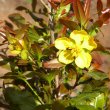
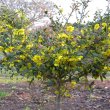
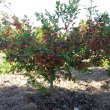
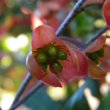
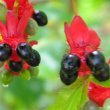
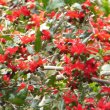
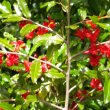
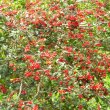
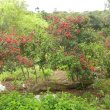


Comments
Hi. I have a bush with seed
Hi. I have a bush with seed and would like to propagate it. I'm not sure whether the seed is in the black berries or in the red base. Both seem to have some form of smaller seeds.
Propagating with seeds
Hi Lynette
The seed is in the big, shiny, black berry. Look at picture 5 of the above images. Inside each black berry is one large seed. Do not remove the black coating. Plant the whole thing. These seeds only remain viable for about three months at most, so plant them as soon as they are ripe.
Kind regards
Lorraine
Discuss this plant
Share knowledge, ask a question or give an experience.